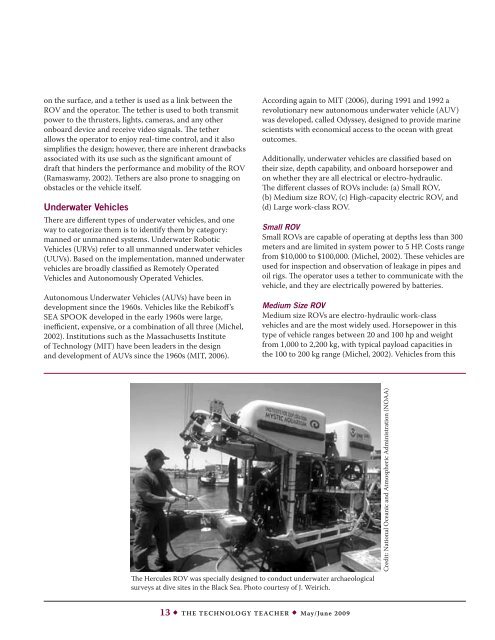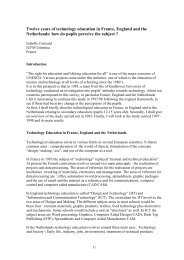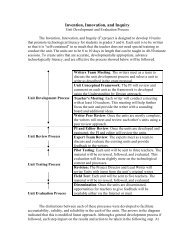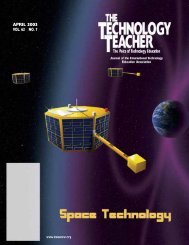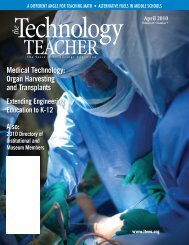May/June 2009 - International Technology and Engineering ...
May/June 2009 - International Technology and Engineering ...
May/June 2009 - International Technology and Engineering ...
You also want an ePaper? Increase the reach of your titles
YUMPU automatically turns print PDFs into web optimized ePapers that Google loves.
on the surface, <strong>and</strong> a tether is used as a link between the<br />
ROV <strong>and</strong> the operator. The tether is used to both transmit<br />
power to the thrusters, lights, cameras, <strong>and</strong> any other<br />
onboard device <strong>and</strong> receive video signals. The tether<br />
allows the operator to enjoy real-time control, <strong>and</strong> it also<br />
simplifies the design; however, there are inherent drawbacks<br />
associated with its use such as the significant amount of<br />
draft that hinders the performance <strong>and</strong> mobility of the ROV<br />
(Ramaswamy, 2002). Tethers are also prone to snagging on<br />
obstacles or the vehicle itself.<br />
Underwater Vehicles<br />
There are different types of underwater vehicles, <strong>and</strong> one<br />
way to categorize them is to identify them by category:<br />
manned or unmanned systems. Underwater Robotic<br />
Vehicles (URVs) refer to all unmanned underwater vehicles<br />
(UUVs). Based on the implementation, manned underwater<br />
vehicles are broadly classified as Remotely Operated<br />
Vehicles <strong>and</strong> Autonomously Operated Vehicles.<br />
Autonomous Underwater Vehicles (AUVs) have been in<br />
development since the 1960s. Vehicles like the Rebikoff’s<br />
SEA SPOOK developed in the early 1960s were large,<br />
inefficient, expensive, or a combination of all three (Michel,<br />
2002). Institutions such as the Massachusetts Institute<br />
of <strong>Technology</strong> (MIT) have been leaders in the design<br />
<strong>and</strong> development of AUVs since the 1960s (MIT, 2006).<br />
According again to MIT (2006), during 1991 <strong>and</strong> 1992 a<br />
revolutionary new autonomous underwater vehicle (AUV)<br />
was developed, called Odyssey, designed to provide marine<br />
scientists with economical access to the ocean with great<br />
outcomes.<br />
Additionally, underwater vehicles are classified based on<br />
their size, depth capability, <strong>and</strong> onboard horsepower <strong>and</strong><br />
on whether they are all electrical or electro-hydraulic.<br />
The different classes of ROVs include: (a) Small ROV,<br />
(b) Medium size ROV, (c) High-capacity electric ROV, <strong>and</strong><br />
(d) Large work-class ROV.<br />
Small ROV<br />
Small ROVs are capable of operating at depths less than 300<br />
meters <strong>and</strong> are limited in system power to 5 HP. Costs range<br />
from $10,000 to $100,000. (Michel, 2002). These vehicles are<br />
used for inspection <strong>and</strong> observation of leakage in pipes <strong>and</strong><br />
oil rigs. The operator uses a tether to communicate with the<br />
vehicle, <strong>and</strong> they are electrically powered by batteries.<br />
Medium Size ROV<br />
Medium size ROVs are electro-hydraulic work-class<br />
vehicles <strong>and</strong> are the most widely used. Horsepower in this<br />
type of vehicle ranges between 20 <strong>and</strong> 100 hp <strong>and</strong> weight<br />
from 1,000 to 2,200 kg, with typical payload capacities in<br />
the 100 to 200 kg range (Michel, 2002). Vehicles from this<br />
The Hercules ROV was specially designed to conduct underwater archaeological<br />
surveys at dive sites in the Black Sea. Photo courtesy of J. Weirich.<br />
Credit: National Oceanic <strong>and</strong> Atmospheric Administration (NOAA)<br />
13 • The <strong>Technology</strong> Teacher • <strong>May</strong>/<strong>June</strong> <strong>2009</strong>


